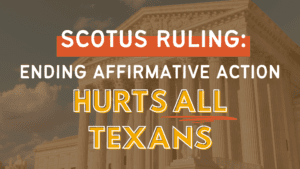
High Hopes, but Low FAFSA Completion Rates
Twitter Facebook Linkedin At the start of the year, educators and families across the U.S. were excited about the release of a better FAFSA. Texans from all corners of this

Twitter Facebook Linkedin At the start of the year, educators and families across the U.S. were excited about the release of a better FAFSA. Texans from all corners of this

All students – regardless of race, class, or gender – deserve affordable post-secondary education. Access to financial aid makes it possible for many students to attain post-secondary education and pursue

All children in Texas have the right to quality public education; according to the Texas Constitution, our public education system must ensure all kids have access to an education that

The 88th Legislative Session ended in historic wins and losses for public four-year colleges and universities that will have a lasting impact on college access and affordability for years to

This week, The Supreme Court ruled against the use of race as a factor in the college admissions process, taking a significant step backward for our country and an additional

View this testimony as a PDF here. Continuing Statutory Over-Regulation of Curriculum Last session, despite significant opposition, this body passed SB 3 that upended how social studies is taught in

The six Every Texan fellows are leaders from across the state of Texas that are committed to working towards creating real change in higher education policy. The six Policy Leaders

Earning a high school degree or credential is a critical step toward Texans accessing opportunities that will allow them to provide for their families and reach their full potential. However,

Higher education is a critical driver of economic progress and family financial stability in Texas. However, the cost of higher education has been consistently increasing while the Texas Legislature has

“Degrees of Debt: What to Do About Rising College Debt in Texas” is a three-part data series by the Center for Public Policy Priorities. Part 2/3 Part 1: Why Is